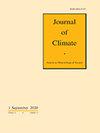热带降水的地带性季节周期:引入印度洋-太平洋季风模式
IF 4
2区 地球科学
Q1 METEOROLOGY & ATMOSPHERIC SCIENCES
引用次数: 0
摘要
摘要 热带辐合带(ITCZ)与强降水带有关,强降水带在季节周期内向经向移动。热带降水也呈带状移动,例如从北半球夏季的南亚季风(JJA)到北半球冬季的西太平洋最大降水量(DJF)。为了探索印度洋-太平洋扇区的这种带状移动,我们利用二维能量框架分析了热带降水的季节周期,并研究了有海洋动力学和无海洋动力学的理想化大气-海洋模拟。在观测到的季节周期中,由于陆地上的升温,春夏季北部南亚上空会形成大气能量和降水异常。然后,由于与太平洋冷舌和赤道东风的相互作用,它在北部秋季向东平流到西太平洋并停留在那里。我们将这一现象解释为 "季风模式",即一种大陆性和季节性的分区传播湿润能量异常。为了理解季风模式的行为,我们建立并探索了一个分析模型,在这个模型中,季风模式由低层风平流,通过与海洋的相互作用而持续,并由于自由对流层的能量混合而衰减。本文章由计算机程序翻译,如有差异,请以英文原文为准。
The Zonal Seasonal Cycle of Tropical Precipitation: Introducing the Indo-Pacific Monsoonal Mode
Abstract The Intertropical Convergence Zone (ITCZ) is associated with a zonal band of strong precipitation that migrates meridionally over the seasonal cycle. Tropical precipitation also migrates zonally; such as from the South Asian monsoon in Northern Hemisphere summer (JJA) to the precipitation maximum of the West Pacific in Northern Hemisphere winter (DJF). To explore this zonal movement in the Indo-Pacific sector, we analyze the seasonal cycle of tropical precipitation using a 2D energetic framework and study idealized atmosphere-ocean simulations with and without ocean dynamics. In the observed seasonal cycle, an atmospheric energy and precipitation anomaly forms over South Asia in northern spring and summer due to heating over land. It is then advected eastward into the West Pacific in northern autumn and remains there due to interactions with the Pacific cold tongue and equatorial easterlies. We interpret this phenomenon as a “monsoonal mode,” a zonally propagating moist energy anomaly of continental and seasonal scale. To understand the behavior of the monsoonal mode, we develop and explore an analytical model in which the monsoonal mode is advected by low-level winds, is sustained by interaction with the ocean, and decays due to free tropospheric mixing of energy.
求助全文
通过发布文献求助,成功后即可免费获取论文全文。
去求助
来源期刊

Journal of Climate
地学-气象与大气科学
CiteScore
9.30
自引率
14.30%
发文量
490
审稿时长
7.5 months
期刊介绍:
The Journal of Climate (JCLI) (ISSN: 0894-8755; eISSN: 1520-0442) publishes research that advances basic understanding of the dynamics and physics of the climate system on large spatial scales, including variability of the atmosphere, oceans, land surface, and cryosphere; past, present, and projected future changes in the climate system; and climate simulation and prediction.
 求助内容:
求助内容: 应助结果提醒方式:
应助结果提醒方式:


